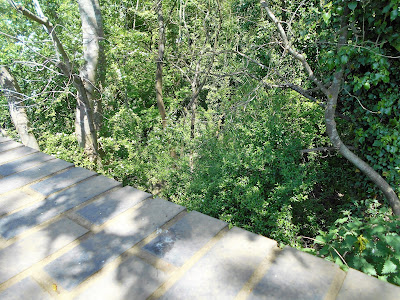 |
| The Twistle, Byfield, looking north. 10 May, 2017 |
There is nothing remarkable about it but my friend Pom Boddington had drawn my attention to a number of galls beside this lane that had caught her eye, so yesterday I visited the area for a closer look. They were oak apples, not remarkable in themselves and in fact I had featured an example in my latest blog ('Bucknell Wood') in which I wrote a little about the nature of these structures.
 |
A group of oak apples beside The Twistle, Byfield.
10 May, 2017
|
But some twenty or more of these galls were easily visible on the first tree I examined and roughly the same number on a second tree, and it was the sheer profusion of them that made the sight unusual. No doubt this quantity is unremarkable but I cannot recall have seen so many.
 |
| Young foliage on an oak. Byfield. 10 May, 2017 |
On the trees the foliage was still unfolding and was of a delicate yellow-green colour; the catkins were of a similar colour. These too are likely to become galled over the next few weeks, again by cynipid wasps but of a different species.
 |
The catkins were similar in colour. The Twistle, Byfield.
10 May, 2017
|
It is still early in the season but already caterpillars were beginning their relentless nibbling. A Dark Dagger moth caterpillar, Acronicta tridens, was at work. The adult moth - the imago - is virtually indistinguishable from the Grey Dagger, Acronicta psi, but fortunately the caterpillars differ and are easy to separate. This larva was barely one centimetre long; it had a lot of growing up to do.
 |
| Larva of the Dark Dagger moth on elm. Byfield. 10 May, 2017 |
A few yards further on and another caterpillar was munching away at elm leaves. It was instantly recognisable as one of the geometrid moths. In America they are known as 'inch worms' from their looping progress in steps of roughly an inch at a time. In this case the species was the Mottled Umber, Erannis defoliaria. This specimen was also very small and only about twelve millimetres in length.
 |
Caterpillar of the Mottled Umber beside The Twistle, Byfield.
10 May, 2017
|
Only one bug was seen. A plant of Wood Dock was being investigated by a Dock Bug, Coreus marginatus. The females will lay their eggs on a dock plant but sorrels and rhubarb (likewise in the Dock Family, Polygonaceae) also act as hosts. The Dock Bug is generally regarded as a shieldbug and is usually included in books on the subject, although it is not a true shieldbug. Roger Hawkins, in his excellent book, Shieldbugs of Surrey, suggests it should be regarded as an honorary shieldbug; the term 'leatherbugs' is also used for the Dock Bug and its close relatives.
 |
Dock Bug on Wood Dock, Rumex sanguineus. The Twistle, Byfield.
10 May, 2017
|
Docks are generally undistinguished plants but support a surprisingly large fauna. The word dock comes from the Anglo-Saxon docca, perhaps related to the Greek daukos. The Greek word really refers to parsnip or carrot which, like dock plants, have long tap roots.
Further down The Twistle a bridge crosses the now-overgrown track-bed of the Stratford-upon-Avon and South Midlands Junction Railway. A camera-shot over the parapet had to be carefully positioned as an enormous amount of rubbish now litters the floor of this cutting.
 |
Best not to look down into this cutting. The litter is a disgrace.
Byfield, 10 May, 2017
|
A few yards further on and I was in Byfield, where a damselfly sat on the foliage of a Clematis. The insect had red eyes and the likelihood is that I was looking at a Red-eyed Damselfly, Erythromma najas. The adults have a cyan-blue thorax (not obvious in this photograph) as does the very similar Small Red-eyed Damselfly, Erythromma viridulum, but the former is more common and is known from the nearby Boddington Reservoir.
 |
Red-eyed Damselfly on clematis foliage, Bell Lane, Byfield.
10 May, 2017
|
I was now well into the village. My walk was over but, before meeting up with my wife, there was just time to look at that curious member of the Poppy Family, the Greater Celandine. This species, Chelidonium majus, is an introduced plant, first recorded in Northamptonshire in 1822, and has never become established in the wild. It is confined to odd corners of waste ground or, as here, at the base of walls.
 |
Greater Celandine grows at the foot of walls in Byfield.
10 May, 2017
|
The broken stems exude a bright yellow-orange sap, once used for topical application to warts but its scientific name has nothing to do with this, coming instead from the Greek word chelidon, a swallow, as the opening of the flowers tends to coincide with the arrival of the first swallows. It is only distantly related to the Lesser Celandine, which is placed in a different family.
Tony White. E-mail: diaea@yahoo.co.uk
Tony White. E-mail: diaea
No comments:
Post a Comment